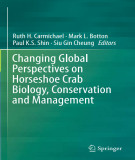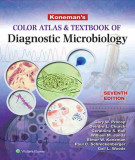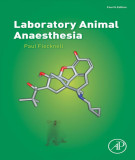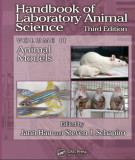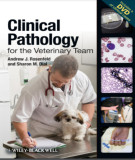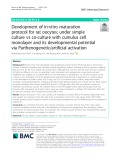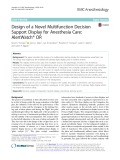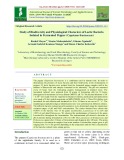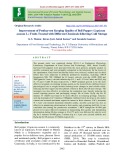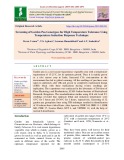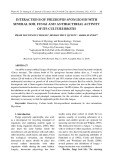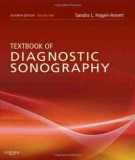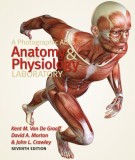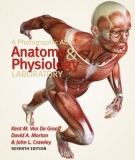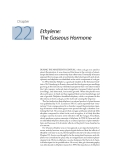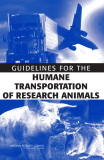
Physiology for the laboratory
-
Part 1 book "Gerontological nursing - Competencies for care" includes content: Introduction to gerontological nursing; the aging population; theories of aging; aging changes that affect communication; therapeutic communication with older adults; review of the aging of physiological systems; assessment of the older adult; medications and laboratory values; changes that affect independence in later life; identifying and preventing common risk factors in the elderly.
 407p
407p  muasambanhan08
muasambanhan08
 01-03-2024
01-03-2024
 1
1
 0
0
 Download
Download
-
Ebook "Changing global perspectives on horseshoe crab biology, conservation and management" reports significant progress of scientific research on horseshoe crabs, including aspects of evolution, genetics, ecology, population dynamics, general biology and physiology, within the recent 10 years. It also highlights the emerging issues related to world-wide conservation threats, status and needs. The contributions in this book represent part of an ongoing global effort to increase data and concept sharing to support basic research and advance conservation for horseshoe crabs.
 619p
619p  duongthandue0501
duongthandue0501
 28-02-2024
28-02-2024
 2
2
 1
1
 Download
Download
-
In ebook "The welfare of domestic fowl and other captive birds" animal welfare is attracting increasing interest worldwide, especially in developed countries where the knowledge and resources are available to (at least potentially) provide better management systems for farm animals, as well as companion, zoo and laboratory animals. The key requirements for adequate food, water, a suitable environment, appropriate companionship and good health are important for animals kept for all of these purposes.
 310p
310p  tachieuhoa
tachieuhoa
 28-01-2024
28-01-2024
 4
4
 2
2
 Download
Download
-
Part 1 book "Koneman’s color atlas and textbook of diagnostic microbiology" includes content: Introduction to microbiology part I - the role of the microbiology laboratory in the diagnosis of infectious diseases; guidelines for the collection, transport, processing, analysis, and reporting of cultures from specific specimen sources; laboratory diagnosis by immunologic methods; molecular microbiology; medical bacteriology - taxonomy, morphology, physiology, and virulence; the enterobacteriaceae,... and other contents.
 1154p
1154p  muasambanhan04
muasambanhan04
 07-01-2024
07-01-2024
 4
4
 1
1
 Download
Download
-
Part 2 book "Laboratory animal anaesthesia" includes content: Analgesia and post operative care; anaesthesia of common laboratory species - special considerations; recommended techniques and physiological data, when no injectable anaesthetic is recommended, inhalational agents should be used; estimation of required quantities of volatile anaesthetics and anaesthetic gases; examples of dilutions of anaesthetic mixtures for small rodents; manufacturers of equipment and other items illustrated or cited in the text.
 181p
181p  muasambanhan02
muasambanhan02
 18-12-2023
18-12-2023
 2
2
 1
1
 Download
Download
-
Part 2 book "Handbook of laboratory animal science (Vol 2)" includes content: Animal models of lung physiology during anesthesia; animal models of female reproduction and fetal growth and development; animal models in vaccinology; animal models in aids research; animal models for the study of helicobacter infection; animal models in mycology; animal models in biodefense research; animal models in oral health sciences; animal models of hearing loss and tinnitus.
 249p
249p  oursky10
oursky10
 07-12-2023
07-12-2023
 3
3
 3
3
 Download
Download
-
Part 1 book "Clinical pathology for the veterinary team" includes content: Sample handling and laboratory standardization - developing standard operating procedures; components of the complete blood count Hematology - the erythrocytes; white blood cells and immune system; abnormalities in the red and white blood cell populations; enal physiology and anatomy, clinical diagnostics, and disease; iver physiology and anatomy, clinical diagnostics and disease.
 118p
118p  oursky05
oursky05
 23-10-2023
23-10-2023
 7
7
 2
2
 Download
Download
-
Murine is the most abundantly used as laboratory animal models. There has been a tremendous amount of research including; their evolution, growth, physiology, disease modeling as well as genomic mapping. Rats and mice are the most widely used among them. Although both rats and mice fall under the same category still both are different a lot too.
 7p
7p  vidarwin
vidarwin
 23-02-2022
23-02-2022
 13
13
 1
1
 Download
Download
-
This paper describes the design of a multifunction alerting display for intraoperative anesthetic care. The design was inspired by the multifunction primary flight display used in modern aviation. Results: The display retrieves live data from multiple sources; the physiologic monitors, the anesthesia information management system, the laboratory values and comorbidities from patient’s problem summary list, medical history or history & physical.
 15p
15p  vampires36
vampires36
 30-12-2021
30-12-2021
 13
13
 0
0
 Download
Download
-
The pepper (Capsicum fructescens) is a condiment used in human food. In order to demonstrate the presence of lactic bacteria and their biodiversity in the fermentation of peppers, 33 lactic bacteria were isolated from the fermented pepper samples sold in the markets of Brazzaville and samples fermented in the laboratory. The pH was measured every 24 hours from the fermenting peppers homogenized in distilled water. The inoculated cultured were prepared from 10 grams of fermenting chili for 24 hours, homogenized in maximum recovery diluent CMO733 pH 7.0.
 8p
8p  chauchaungayxua11
chauchaungayxua11
 23-03-2021
23-03-2021
 11
11
 2
2
 Download
Download
-
The present study was conducted during 2013-14 in Postharvest Physiology Laboratory, Department of Food Science and Technology, UHF, Nauni. Freshly harvested bell peppers were procured from the local growers, properly packed in suitable containers and were promptly transported to the laboratory for the layout of the experiments.
 14p
14p  chauchaungayxua8
chauchaungayxua8
 03-10-2020
03-10-2020
 14
14
 2
2
 Download
Download
-
Garden pea is a cool season leguminous vegetable crop with a temperature requirement of 15-23°C, for its optimum growth. Thus, it is mainly grown as a rabi season crop in India. Increased CO2 concentration in the environment has led to global warming. All the seedlings of pea lines were taken in uniformly after 48h and grown in completely randomized design (CRD) block with three replications having twenty seedlings per replication. The experiment was conducted in the laboratory of Division of Plant Physiology and Biochemistry, ICAR- Indian Institute of Horticultural Research, Bengaluru.
 9p
9p  cothumenhmong3
cothumenhmong3
 22-02-2020
22-02-2020
 17
17
 1
1
 Download
Download
-
An edible ectomycorrhizal fungus Phlebopus spongiosus have been found in pomelo orchards (Citrus maxima). The culture broth of Ph. spongiosus became darker after ca. 3 weeks of inoculation. The dry production of culture broth extract (culture extract) was 0.30 ± 0.09 g per culture (20 ml broth in a 50 ml flask).
 9p
9p  chauchaungayxua1
chauchaungayxua1
 03-12-2019
03-12-2019
 39
39
 0
0
 Download
Download
-
(BQ) Part 1 of the document Textbook of diagnostic sonography presents the following contents: Foundations ofsonography; introduction to physical findings, physiology and laboratory data; essentials of patient care for the sonographer; ergonomics and musculoskeletal issues in sonography,...
 595p
595p  thangnamvoiva3
thangnamvoiva3
 01-07-2016
01-07-2016
 39
39
 5
5
 Download
Download
-
(BQ) Part 1 of the document A photographic atlas anatomy and physiology for the laboratory presents the following contents: Terminology and orientation, microscopic anatomy, support and movement, integration and coordination.
 107p
107p  thangnamvoiva2
thangnamvoiva2
 25-06-2016
25-06-2016
 40
40
 2
2
 Download
Download
-
(BQ) Continued part 1, part 2 of the document A photographic atlas anatomy and physiology for the laboratory presents the following contents: Maintenance of the body, continuance of the species, vertebrate dissections.
 119p
119p  thangnamvoiva2
thangnamvoiva2
 25-06-2016
25-06-2016
 55
55
 2
2
 Download
Download
-
Laboratory for Phytopathology and Plant Protection, Katholieke Universiteit Leuven, Leuven, Belgium; 2Institut de Pharmacologie et ´ Biologie Structurale, Unite Mixte de Recherche Centre National de la Recherche Scientifique 5089, Toulouse, France; 3Institute of Plant Biochemistry, Halle, Germany; 4Laboratory of Developmental Physiology and Molecular Biology, Katholieke Universiteit Leuven, Leuven, Belgium
 11p
11p  system191
system191
 01-06-2013
01-06-2013
 48
48
 3
3
 Download
Download
-
The summer/winter difference in plasma volume may be related to the regularly observed summer fall in red blood cell values and total protein. In a fully dehydrated camel with 65% body water, alimentary water has been reported as 12%, which is similar to the figure for tropical cattle. The total water content of the camel is considerably greater in hot dry weather (up to 75%) than in cooler periods (down to 50%), which indicates its physiological water conserving capability.
 0p
0p  conduongdinhmenh
conduongdinhmenh
 07-05-2013
07-05-2013
 44
44
 9
9
 Download
Download
-
DURING THE NINETEENTH CENTURY, when coal gas was used for street illumination, it was observed that trees in the vicinity of streetlamps defoliated more extensively than other trees. Eventually it became apparent that coal gas and air pollutants affect plant growth and development, and ethylene was identified as the active component of coal gas. In 1901, Dimitry Neljubov, a graduate student at the Botanical Institute of St.
 20p
20p  anhphuonggl
anhphuonggl
 11-04-2013
11-04-2013
 88
88
 6
6
 Download
Download
-
This project was initiated in response to a letter from Charles Kean, an Associate Professor of Physiology and Pharmacology and Director of the Animal Care Facility at Loma Linda University, to the National Research Council’s (NRC’s) Institute for Laboratory Animal Research (ILAR), the Association for Assessment and Accreditation of Laboratory Animal Care (AAALAC) International, and the Office of Laboratory Animal Welfare (OLAW) of the National Institutes of Health (NIH) outlining the research animal care community’s concerns about the safe and humane transportation of research animals. Dr.
 165p
165p  mnemosyne75
mnemosyne75
 02-02-2013
02-02-2013
 48
48
 3
3
 Download
Download
CHỦ ĐỀ BẠN MUỐN TÌM









